Gutter Maintenance is very important for your home. Keeping your gutters clear from obstructions can save you a lot of money and headache. Once your gutters get clogged, the water can’t flow properly through the system, and ends up leaking out wherever it can. Often times, these leaks end up causing water damage to your home.
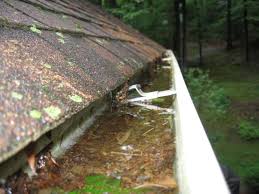
Fortunately, if you own a ladder and are comfortable with heights, you can perform simple gutter maintenance yourself and keep your gutters free and clear all year long. Follow these simple Gutter Maintenance Tips from us to make sure your gutters don’t get clogged and cause damage again.
Things you will need:
- Extension Ladder (24′ for 2 story homes, 28′ or 32′ for 3 story, 40′ for very tall buildings and 4 story)
- Gloves
- Bucket (For water and/or carrying tools)
- Trash Bags (For removing debris)
- Cloth or Rags for wiping gutters
- Cleaning Products
- Hammer
- 1/4″ hex socket w/ratchet
- Spotter (helper)
- Phillips Screwdriver (for gutter screws)
CLEANING THE GUTTERS
The most important routine gutter maintenance that you can do yourself, is cleaning the gutters. You don’t want any debris in there, ever. Debris leads to obstructions and clogs. Clogs lead to repairs that cost money.
To clean the gutters you will need a ladder, gloves, trash bags, and a helper. We always recommend a helper for this part because you will be all the way up the ladder, or maybe climbing onto the roof.
There’s two ways to go about this, and it depends on your level of comfort with heights. Most professional gutter cleaners will find one spot on the roof that they can access the entire roof from, and set their ladder there. Next, they’ll climb up onto the roof so they are now standing on the roof. This is why a spotter is important, in case something happens to your ladder and you need help. The other way you can go about this, is by working from the ladder. What this means is you climb up the ladder to the roof edge, but you don’t actually mount the roof. You will have to perform all the work from the ladder. I personally do this from the ladder, as I have a fear of heights and am not comfortable with getting on the roof. But, working from the ladder has it’s disadvantages too. It takes a lot longer because you have to climb up and down the ladder, then move the ladder to every location. If you have a lot of debris in your gutters, then you could be climbing up and down and moving the ladder all day.
REMOVING THE DEBRIS
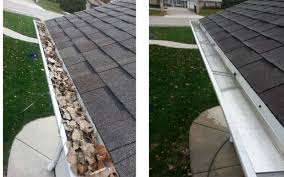
Whether you work from the ladder or from the roof, you still clean the gutters the same way. You simply scoop out all the debris and put it into trash bags. This stuff often is mushy and slimy, so you’re going to want to put on gloves. Scoop as much out as possible in every location. If there is sludge or mud in the gutter, get as much out as you can. Shingle grit often ends up in the gutter and other small particles. It is impossible to completely clean all this stuff, and it will wash out in the next good rain anyway, so don’t sweat the small stuff.
You can use a cloth and cleaning product of your choice to clean the outsides of your gutters. But, often times if it’s caked on there you may need to get them pressure washed. Always be careful when cleaning the outsides of the gutters, not to use too much pressure that you dent or bend the gutter.
CHECKING THE DOWNSPOUTS
The most vulnerable spot on your gutter system, is the downspout elbows. This is where 95% of your clogs are going to occur. A simple clog in the downspout can cause many different problems. But, the easiest way to know is when water is over flowing near the downspout. This is usually a tell tale sign that your downspout is clogged.
Often times you can see debris piling up in the downspout, but not always. Sometimes you’ll be on the roof looking into the downspout and see nothing, but a clog ends up being there anyway. There’s only a couple ways to know for sure if your downspout is clogged or clear.
- Run water through the downspout (Hose)
- Blow air through the downspout (Leaf blower)
- Drop something through the downspout
Whether you run water or air through it, the outcome is the same. You should see a steady flow of water, or stream of air. If there’s grass around, you can see it moving. This is also where your spotter can help. The spotter can stand near the downspout to verify if the air is coming out the other side.
If you don’t have access to a hose or leaf blower, you can always drop something small in the downspout to see if it comes out the other side. Some popular items people use for this method are: screws, marbles, BB’s, golf balls, etc…. basically something heavy but smooth enough that it won’t get caught up in small crevices.
CLEANING THE DOWNSPOUTS
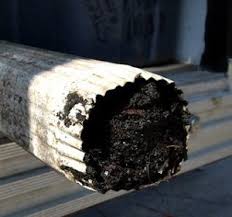
Water can not drain properly through this.
If it you determine that the downspout is clogged, there’s really only one way to clear it. 99% of downspout clogs occur in the downspout elbow, so you’ll need to disassemble that downspout at the elbow. For this you’ll need the 1/4″ socket or wrench. Each downspout section each slides into each other like a sleeve. Also, 1’4″ pins are used to screw the 2 sections together and make them secure. You simply need to loosen the screws (usually 2) then pull the downspout sections apart.
After you have removed any screws and pulled the sections apart, it’s time to clear the obstruction. Sometimes you’ll be able to just shake it loose and the stuff will fall out. If it’s caked in there, you may have to poke it with something like a stick or a screw driver. Whatever it takes to bust everything loose, but while taking care not to dent or crimp the downspout sections.
Once you have cleared it to a satisfactory level, all you need to do is put it back together. Simply slide the pieces back together how they fit, and then put the screws/pins back in the same spots. All pieces should fit tight and secure.
LOOSE GUTTER SPIKES
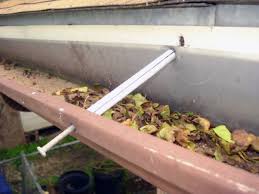
The last of the simple gutter maintenance tips that we are going to tell you about, is keeping an eye out for loose gutter spikes.
The old style of hardware used to mount the gutter to the wall go by many names like gutter spikes, gutter nails, gutter screws, etc… But they all are basically the same thing. A big spike driven through the gutter. You can see these spikes all around your home.
Gutter Spikes slowly pull loose over time, and neglect can make them pull loose even faster. If debris accumulates and forms a clog, water can’t escape. Once the water pools up it gets very heavy inside the gutter, causing a lot of stress on the mounting hardware. This will pull them loose from their holes. Luckily for you, this is usually a simple fix.
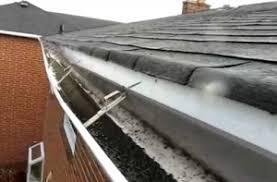
TAPPING IN LOOSE GUTTER SPIKES
All you need to do is hammer the loose gutter spikes back into place. For this, you will only need a ladder and a hammer. It’s easier to perform this task from the ladder than from the roof. You get a straight view of what your doing, instead of upside down. Next, you just “tap” the gutter spike back into place. If it has completely pulled from the wall, you may need to guide the spike back to its hole in the wall before you tap it back into place.
Gutter Screws are Gutter Spikes with threads. They usually have a Phillips head so you would need a screw driver instead of a hammer. If your Gutter Spikes have wore out their holes and keep pulling loose, you can try replacing with Gutter Screws because the threads will have better luck catching something.
The new way to mount gutters is with screw-in hidden hangers that pull the gutter to the wall. If you have these, you won’t be able to see them from the ground because they are “hidden” inside the gutter. To tighten these you will need to figure out what size hex pin they have, and use a wrench or drill to tighten them a little past finger tight.
CONCLUSION
Routine Gutter Maintenance can and will save you a lot of money. Clogged gutters or downspouts can lead to basement leaks/flooding and extensive wood repairs all around your home. How often you should check and clean your gutters depends on the tree coverage in your area. If you have very little or no trees, you should still perform gutter maintenance once a year. Birds, squirrels, and wind will still carry stuff up there, and it’s good to get a look at your roof at least once a year to make sure everything looks good. For homes with medium coverage, we recommend 2 gutter cleanings per year. After Spring (late May-June) and after Fall (December-early January) are the 2 most crucial times to clean your gutters.
CONTACT THE EXPERTS AT MY GUTTER PRO

MY GUTTER PRO
93 Monocacy Blvd. A-6
Frederick, MD 21701
(973) 852-6987
Does your home have gutters???
If you answered yes, then you should be following My Gutter Pro on Facebook. We give out seasonal reminders, DIY tips (like this blog), promo offers, FAQ’s, contest and giveaways and much more! Don’t delay, join the My Gutter Pro Team , today!!!
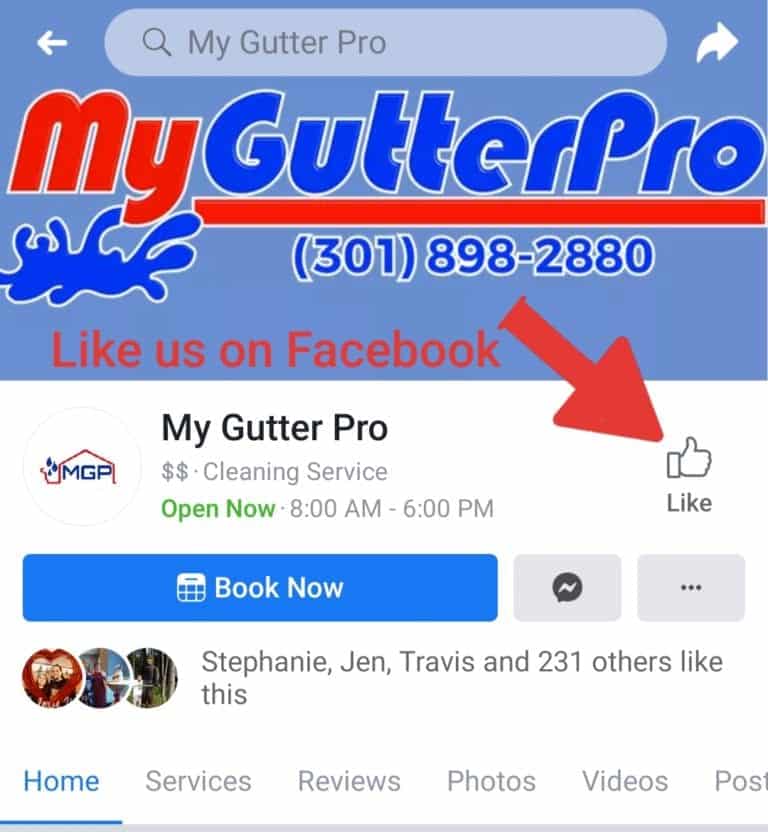
Check out some of our other related Blog articles

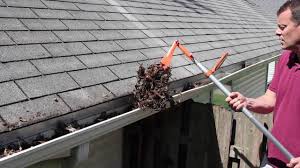


4 Responses
Thanks for the reminder that I have to be mindful of how tight the spikes are installed on gutters. I will make sure that address that when getting gutter repair services soon. I’m sure that there will be a lot of fasteners to tighten or replace for that.
I want to protect my home’s roof from heavy rainfall, and that is why I’ve decided to look for a service that may install a gutter in it. I also agree with you that it will be wiser to opt for good quality gutters. Thank you for sharing the importance of preventive maintenance.